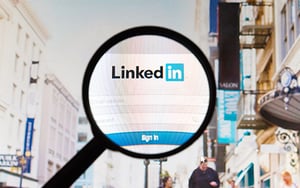Setting Resolutions—Reaching Goals
We made it! We got through 2019, so it’s time to look forward to 2020. Our blog post from  2019 highlighted conversational marketing, creating and promoting videos, account-based marketing, brand evangelism, and long-form content; and while all of these are still relevant for 2020, there’s another group of trends that are elbowing their way into the spotlight and deserve some attention for the new year.
2019 highlighted conversational marketing, creating and promoting videos, account-based marketing, brand evangelism, and long-form content; and while all of these are still relevant for 2020, there’s another group of trends that are elbowing their way into the spotlight and deserve some attention for the new year.
For a few years now, marketing technologies have been running full speed, offering different services and showcasing all the data that can be mined from their analytics. As we move forward, we’re seeing marketing strategies where you take a step back from racing ahead to consider what’s really working and what isn’t in your marketing and communications tactics.
If you’re still working on a marketing strategy for your company, or not sure where to start—or maybe you just want validation that you’re on the right track—these are some of the trends we’re going to see through 2020.
Web Development
A post by Altitude Marketing highlighted this general theme for 2020: we’ll be more  conscious of what marketing efforts we make rather than doing everything at a fast pace just because we can. One area of focus that warrants a more thoughtful look is your website. While there are a number of website themes that can be purchased for cheap or accessed for free, it’s becoming more important to work on building a custom website that satisfy your company’s needs, both for content and security, that your customers will recognize and trust.
conscious of what marketing efforts we make rather than doing everything at a fast pace just because we can. One area of focus that warrants a more thoughtful look is your website. While there are a number of website themes that can be purchased for cheap or accessed for free, it’s becoming more important to work on building a custom website that satisfy your company’s needs, both for content and security, that your customers will recognize and trust.
There isn’t much point in layering on different plug-ins and technologies if the core of your website doesn’t function well. Trying to fit your company’s framework into a cookie-cutter theme can also hold you back on representing who you are and engaging with the right people.
When talking about websites, we have to also talk about SEO (search engine optimization). SEO continues to be a driving force for the success of your website and your content, so your website and framework should do all that it can to support best SEO practices. Lead Agency reported that “Google rolls out changes to its algorithm 500 to 600 times a year. No B2B marketer can be expected to stay on top of every single one of these updates, but it’s important to ensure your website is well-optimized for current (and future) algorithms.” The best way to stay ahead of the game is to focus on your customers and their buyer’s journey as they visit, or re-visit, your website. It’s almost impossible to keep up with the constantly changing algorithms, so take a step back and focus on who is visiting your site. With that as your main focus, your SEO will always be at a level that works for your customers, and Google makes changes ultimately based on the users of the websites they’re ranking. Does your web page provide answers and resources to customers with a specific problem? Is it visually appealing and easy to navigate?
Lead Agency also reported on the increasing use of voice search: “Currently, 40% of adults perform a voice search daily, and it has been predicted that by 2020 50% of all searches will be voice searches.” You need to think about how customers are searching for your website and your services. Longer keywords are something to consider when optimizing your SEO for voice search.
Higher-Quality Content
Content is, and probably always will be, king. The kind of content you’re developing is  important and will vary based on your customer needs. Video is still on the rise, with Altitude Marketing stating, “70% of B2B buyers and researchers watch videos on their path to purchase. More marketers are taking note of this trend, with 45% of marketers planning to add YouTube, and 41% Facebook Video, to their marketing strategies.”
important and will vary based on your customer needs. Video is still on the rise, with Altitude Marketing stating, “70% of B2B buyers and researchers watch videos on their path to purchase. More marketers are taking note of this trend, with 45% of marketers planning to add YouTube, and 41% Facebook Video, to their marketing strategies.”
In addition to video, long-form content (over 1,000 words) is also becoming more important, since customers visiting your website are looking for valuable insight and information. One long-form post will be more effective than four shorter and less relevant fluff pieces.
Think about what high-quality content you’re able to produce and if it would be useful to your customers. Is it videos, white papers, or insightful long-form pieces? Selecting what works best and taking the time to create valuable pieces will lead to higher-quality lead generation.
Personalization
Overlapping with content and website development, is personalization. Whether it’s B2B or B2C, people want timely and customized communications or responses to their inquiries. Chatbots are one way companies are utilizing opportunities for personalization on their websites. Businesses are predicted to invest $400 million in chatbots in 2021, while 80% of enterprises will want personalized chatbots by 2020, as shared by Forbes. Chatbots allow you to schedule meetings and demos, resolve quick customer service issues (helping avoid lag time for responses with simple solutions), and capture lead information. HubSpot offers a Knowledge Base system, where someone asks for a specific piece of content or certification and is immediately directed to what they’re looking for without waiting for a representative to get back to them, saving time on both ends and creating a better customer experience.
B2C, people want timely and customized communications or responses to their inquiries. Chatbots are one way companies are utilizing opportunities for personalization on their websites. Businesses are predicted to invest $400 million in chatbots in 2021, while 80% of enterprises will want personalized chatbots by 2020, as shared by Forbes. Chatbots allow you to schedule meetings and demos, resolve quick customer service issues (helping avoid lag time for responses with simple solutions), and capture lead information. HubSpot offers a Knowledge Base system, where someone asks for a specific piece of content or certification and is immediately directed to what they’re looking for without waiting for a representative to get back to them, saving time on both ends and creating a better customer experience.
Forbes also reports that 72% of buyers expect B2B companies to personalize communications in a way that suits their needs, with communications tailored to the buyer’s preferences and location in the buyer’s journey. Do what you can to engage your prospect across your website, social media, and email marketing with personalization; this requires that you research the needs of your target market ahead of time.
Email Marketing
Speaking of email marketing, this guy isn’t going anywhere anytime soon. Rather than  being a trend, email marketing is a staple of digital marketing that should always have a place in your strategy. Forbes suggests utilizing dynamic content and AI to boost the open rates of your emails. This is where personalization can come into play, as well. Based off of your target audience or market, you can segment lists that offer different content relevant to that specific buyer, while also going a step ahead to deliver the content based on optimal email open times, or triggered based off of previous website behavior.
being a trend, email marketing is a staple of digital marketing that should always have a place in your strategy. Forbes suggests utilizing dynamic content and AI to boost the open rates of your emails. This is where personalization can come into play, as well. Based off of your target audience or market, you can segment lists that offer different content relevant to that specific buyer, while also going a step ahead to deliver the content based on optimal email open times, or triggered based off of previous website behavior.
Dynamic email providers offer a number of ways of personalizing your email based on the reader’s activity. Work on utilizing all the functions an email provider can offer, from personalization and scheduling to triggered email campaigns based on actions. With some planning and strategy ahead of time, you can set up email campaigns that almost run themselves (at least for a period of time).
Make sure your formatting is suitable for desktops and smartphones, since open rates for smartphones have only increased over the years. Making sure that your emails are mobile responsive and also won’t be flagged as spam by email providers such as Google and Apple Mail will help boost your delivery and open rates.
Investing in Strategy
According to an article by Forbes, B2B decision makers are a lot younger these days, with more than 70% of millennials included in B2B buying decisions. They also see buyers and decision makers doing at least 12 searches online before engaging with a website. With more selective prospects, you need to make some investments in your strategy to make your website and content discoverable.
One way is through leveraging social media. Some companies may turn their heads at the mention of social media, but with younger decision makers entering the market, this field should not be ignored. Social media is a great opportunity to build brand awareness and trust, with more opportunities for lead capture and sharing content.
mention of social media, but with younger decision makers entering the market, this field should not be ignored. Social media is a great opportunity to build brand awareness and trust, with more opportunities for lead capture and sharing content.
Lead Agency suggests that LinkedIn can be a great place to start for B2B marketers: “There are more than 590 million active professionals on LinkedIn and according to a Demand Gen report, 80% of B2B leads come from LinkedIn. The platform has over 60 million senior-level influencers, 40 million decision makers, and 10.7 million opinion leaders, and it’s only predicted to keep growing in 2020 and beyond.”
Another investment to consider is advertising. Lead Agency reports, “Programmatic advertising is considered to be the future of digital advertising. Google is aiming for 60% of digital advertising spend to go to programmatic advertising by the end of 2020.” Programmatic advertising essentially automates the bidding process using analytics data, as opposed to using traditional ad-buying methods to purchase ad spots, as explained by Lead Agency.
Pay-Per-Click (PPC) advertising is still in the ring, as well, with opportunities to act smarter when you re-evaluate your strategies. According to Altitude Marketing, we’ll see people change their bidding strategies to become focused on who the buyer is and what they want for 2020. Make sure the keywords you’re bidding on are specific to your company or a solution your company offers. This boosts the opportunity you have for winning the bid on a specific keyword and keeps your costs down.
Setting Resolutions—Reaching Goals
Whether or not your fiscal year ends with the calendar year, the start of a new year (and new decade, in this case) is a great time to re-evaluate your marketing strategies. Not only is your company coming back with a sense of motivation to start the new year off right, but customers may be in the same mindset as well.
Between website development and content strategy, there’s plenty to consider and keep track of. Grant Marketing can help you in all of these areas relative to the goals you and your company set. Contact us today to learn more about how we can work together.


